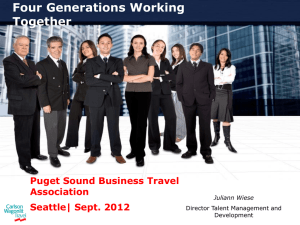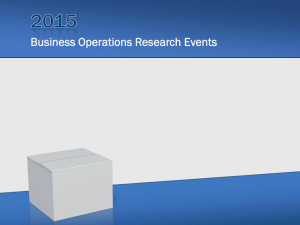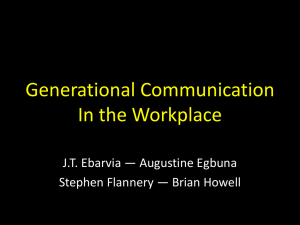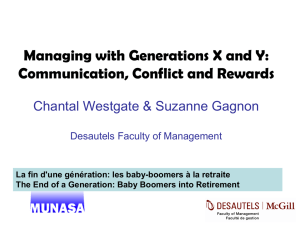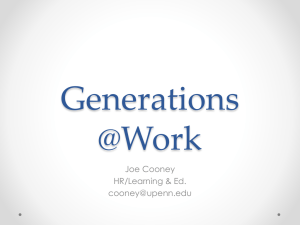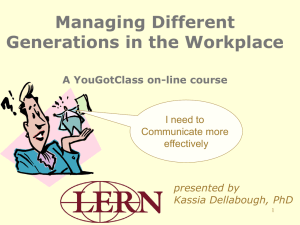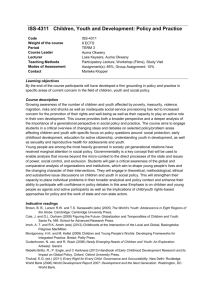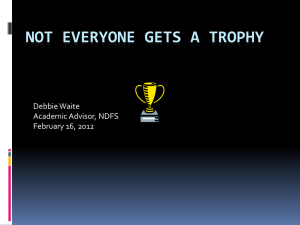Chapter 1 Slides
advertisement
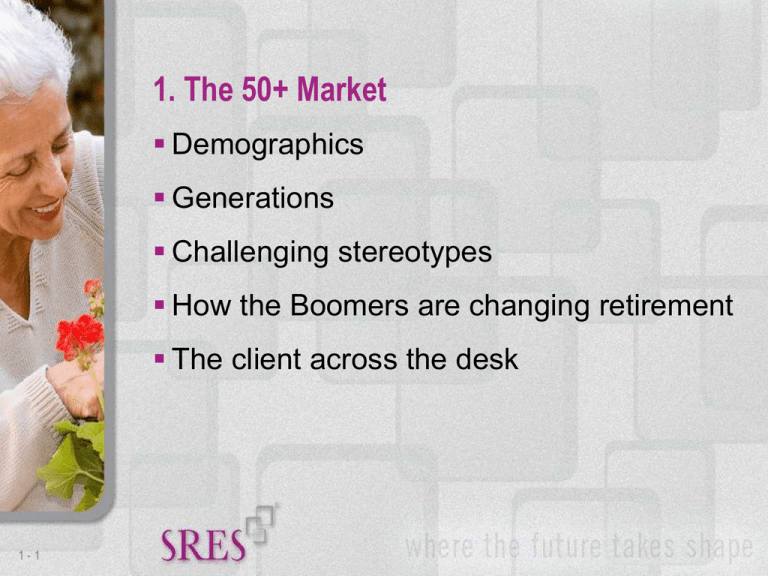
1. The 50+ Market Demographics Generations Challenging stereotypes How the Boomers are changing retirement The client across the desk 1-1 Large and Fast-Growing Market Segment One in three Canadians is a Baby Boomer. Number of seniors in Canada will increase 200% between 2005 and 2036. 1-2 Demographics and Generational Characteristics Provide insights into what is important to clients and customers Learn about viewpoints, reactions, motivations, lifestyles, hopes, and fears Help us understand how best to communicate and market 1-3 Demographics and Generational Characteristics Born % of Canadian Population prior to 1937 3.7% Active Retiree 1938–1947 13.96% Baby Boomer 1948–1962 31.2% Lost and Full Retiree Generations 1-4 Demographics and Generational Characteristics 1-5 Born % of Canadian Population Generation X 1963–1976 12.4% Generation Y 1977–1994 26.1% Generation Z 1995– present 12.3% Defining the Market Generational profiles inform how : Services are provided Marketing communications are developed Buyers and sellers are counseled 1-6 Lost and Full Retiree Generational Profile 1-7 Born: Prior to 1937 Age in 2010: 73 years and older These Members Are: •Parents of Baby Boomers •Grandparents of Gen X Formative Experiences: •Depression •WW II Attitudes: •Energetic •Courageous •Loyal •Community oriented •Hardworking •Team players •Respect for authority Active Retiree Generational Profile 1-8 Born: 1938–1947 Age in 2010: 63–72 These Members Are: •Parents of Gen X •Grandparents of Gen Z Formative Experiences: •WWII •D-Day in Normandy •Korean War Attitudes: •Cautious •Conformist •Risk averse •Unimaginative Working with Lost and Full and Active Retirees Providing Services: Feel that “service isn’t what it used to be.” Decision Making: May appear indecisive, overly cautious. Afraid of out-living their assets. Help them feel empowered to make a good decision. Decisions are driven by circumstance, not the market. May be concerned w/image when downsizing. Counselling: 1-9 Address them as Mr. and Mrs. Shake hands. Honor the need for independence. Ask a lot of questions to find out what they really want. Show the options and explain all the details. Working with Lost and Full and Active Retirees Response Time: View of Experts: Value personal referrals. Provide testimonials and resume. Information Access: Technology is a bit mysterious, but a handy tool for communications and entertainment. Marketing Dos and Don’ts: Help clients feel empowered Be courteous and interact face to face. Do not patronize. Be aware of physical limitations. Relationship marketing is key. 1 - 10 For follow up, schedule a specific time when you will respond. Make a telephone appointment and explain that you will address their concerns during that appointment. Baby Boomer Generational Profile 1 - 11 Born: 1948–1962 Age in 2010: 48–62 These Members Are: •Children of the Lost and Full Retirees •Parents of Gen Y Formative Experiences: •Assassinations of JFK, Martin Luther King, and Bobby Kennedy •Cuban Missile Crisis •Vietnam •Moon landing •Woodstock and hippie culture Attitudes: •Ambitious •Optimistic •Individualistic •Immediate gratification •Careerist •Hardworking •Competitive •Materialistic •Nostalgic about childhood Working with Baby Boomers Providing Services: 1 - 12 Value convenience and customization Do not need emotional support or hand-holding Hate rules Decision Making: Not in a hurry Generally not needs driven Expect numerous “be-back” visits Counselling: Buyers value representation of interests and managing the process; sellers value pricing properties right, representation of interests, and managing the process. Working with Baby Boomers Response Time: Expect a timely response, but not necessarily instant turnaround Decision Making: Want and expect expert services and advice Emphasize your network of experts Be able to back up your knowledge with experience and credentials Information Access: Marketing Dos and Don’t’s: 1 - 13 Do not want information they can find themselves Provide the highlights Technology is a tool for communications and work. Boomers do not see themselves as old, anything labeled as “senior” is a tough sell. Marketing should be age targeted, not age restricted (Boomers hate rules) Interact in person or by telephone Appeal to the active lifestyle Gen X Generational Profile 1 - 14 Born: 1963–1976 Age in 2010: 34–47 These Members Are: •Children of Active Retirees •Parents of Gen Z Formative Experiences: •Berlin Wall •Chernobyl •Challenger explosion •Iran hostage crisis •Technology and video games Attitudes: •Skeptical •Latchkey kids •Isolated •Cynical •Entrepreneurial •Independent •Quality of life/family before career •Self-reliant •Pragmatic •Reluctant to commit Working with Gen X Providing Services: Decision Making: Counselling: 1 - 15 Want you to provide access and get the paperwork done. Negotiate price and details. Will not need hand-holding or emotional support. Pragmatic, risk-takers, results oriented. Sense of entitlement. High tech/low touch. Help them interpret information. Working with Gen X Response Time: Expect prompt response time (maximum two hours). Deliver everything yesterday. View of Experts: Skeptical. Information Access: Likely to rely on themselves to find data. Technology is a way of life and means of empowerment. Marketing Dos and Don’t’s: 1 - 16 One chance to get it right.Do not try to “sell” them anything.Awareness level is very high.They already know the good deals. Gen Y Generational Profile 1 - 17 Born: 1977–1994 Age in 2010: 16–33 These Members Are: •Grandchildren of the Lost and Full Retiree Generations •Children of the Baby Boomers Formative Experiences: •September 11 attacks •Internet •Gulf War •Columbine shootings •Globalization Attitudes: •Empathic with elders •Sheltered •Tolerant •Sensitive to multiculturalism •Inclusive •Hopeful •Over-scheduled and time-pressured •Multitaskers •Short attention span Providing Services: Decision Making: Working with Gen Y High tech/low touch. Counselling: Pragmatic, but empathic with elders. Value personal contact. Prefer directness over subtlety, action over observation. Above all, keep cool. 1 - 18 Working with Gen Y Response Time: Crunched for time, always multitasking. Expect you to multitask, too. Everything is scheduled. Communicate by email and instant-messaging. View of Experts: Heavily influenced by media and peers. Information Access: Marketing Dos and Don’t’s: 1 - 19 High speed, instant access is expected. Technology is a way of life. No pretensions. Avoid the appearance of overpromising. Influenced by the look of your Web site. Exercise: Generations What are the ages of the oldest and youngest persons in your family and office? Where do you fit in your family’s ranges of ages and generations? How do the generational differences impact communications in your family and office? 1 - 20 Myth: Old people are the same Reality: We become more biologically diverse as we deal with a combination of chronic health conditions. We “age” at different rates. 1 - 21 Myth: Families “dump” relatives into nursing homes Reality: A last resort for most Less than 10% of the elder population live in nursing homes. Most families provide in-home care. 1st choice–services that allow elders to stay in their own homes 1 - 22 Myth: Old equals ill and disabled Reality: More than 3/4 of Canadians their health as good, very good, or excellent. 1 - 23 Myth: Lonely and withdrawn Reality: Close friends and relationships same as younger people. Friends, family and community are a motivation to age in place. Preference not to live with children Transportation is important for social involvement and independence. 1 - 24 Myth: Afraid of technology Reality: Active users of the Internet Boomers will continue the trend Use Internet for e-mail, search properties, research neighborhoods 1 - 25 Myth: Living in poverty or wealth Reality: Seniors are less likely to live in poverty Between 1980 and 2003, average total income (after tax) received by senior couples increased by 18% Home represents greatest equity 1 - 26 Myth: Likely to be crime victims Reality: Older people are less likely to be victims of crime than young people. 1 - 27 The Client Across the Desk No “one size fits all” answer. Not every aging issue is an issue for every senior client . Chronological age does not equal life stage, lifestyle, or activity level. Think health stage or activity stage. 1 - 28 F.O.R.D. F = Family/Friends O = Occupation R = Recreation/hobbies D = Dreams 1 - 29 The Opportunity As circumstances change, mature adults will: • buy and sell • upsize and downsize • move to a new location • move back or “half-back” to be close to family • move to assisted living environments • and more Clients for life Become the real estate professional who can help them through the phases 1 - 30 Golden Rule Everyone hopes to be a senior one day and be treated then as you would want to be treated now. 1 - 31

